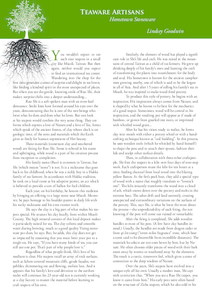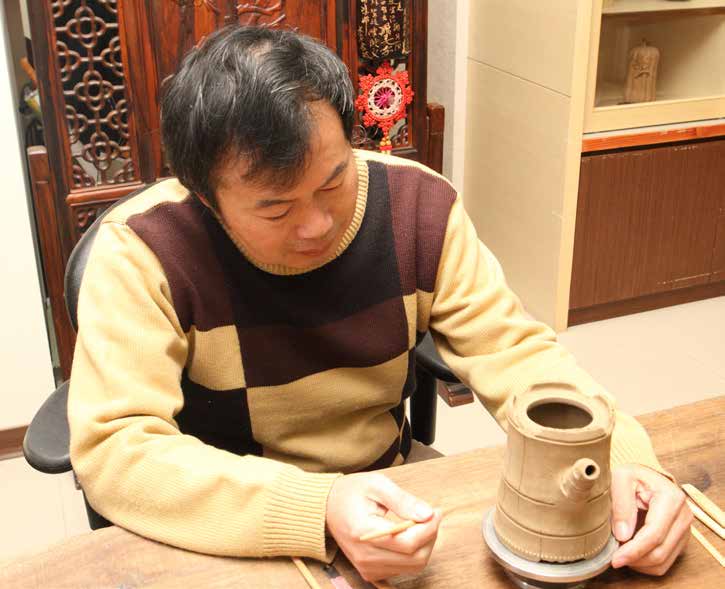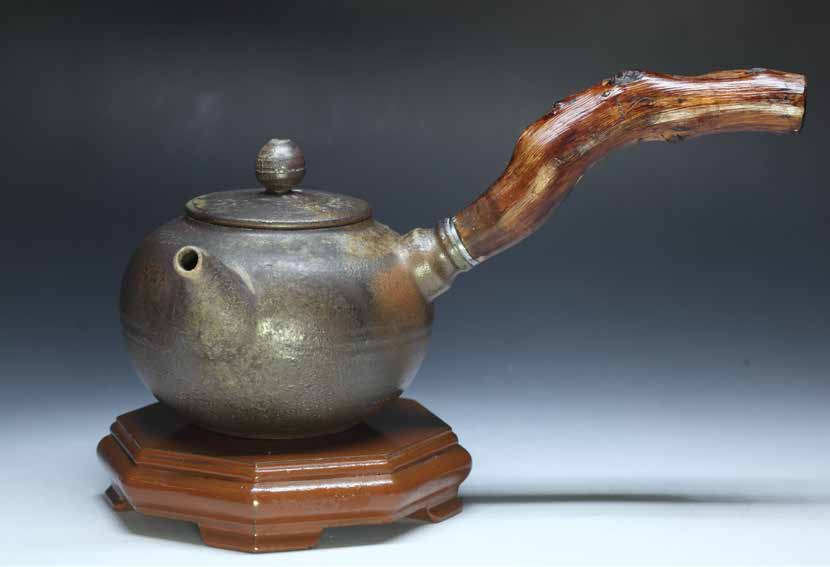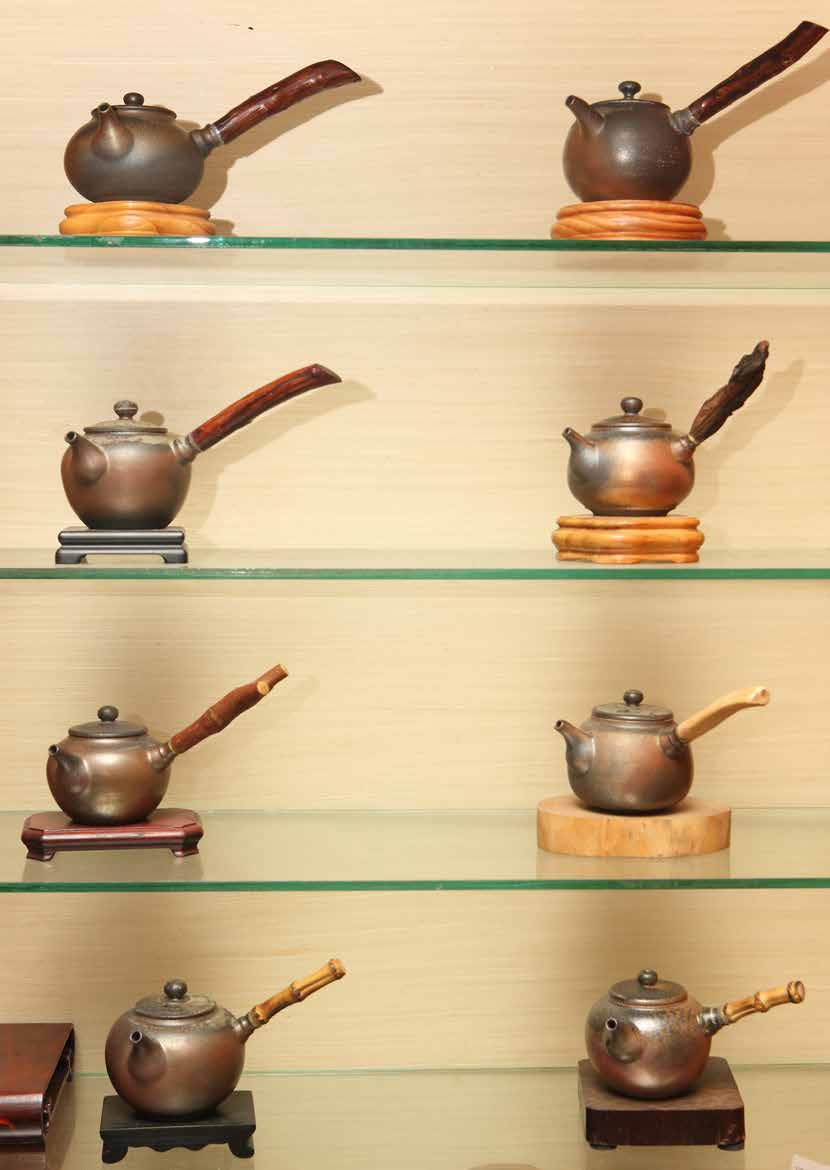
 |
|
You wouldn't expect to see such nice teapots in a small city like Miaoli, Taiwan. But then again, neither would you expect to find an international tea center. Wandering into the shop for the first time generates a sense of surprise and delight in tea lovers, like finding a kindred spirit in the most unexpected of places. But when you see the gentle, knowing smile of Ruo Shi, their maker, surprise shifts into a deeper understanding...

Ruo Shi is a soft-spoken man with an even-keel demeanor. Smile lines have formed around his eyes over the years, demonstrating that he is one of the rare beings who loves what he does and does what he loves. But one look at his teapots would confirm the very same thing. They are forms which express a love of Nature and a love of Tea, forms which speak of the ancient forests, of clay whose clock is on geologic time, of the eons and materials which the Earth gives so freely for human expressions of Her beauty.
These materials (stoneware clay and weathered wood) are fitting for Ruo Shi. Stone is echoed in his name and upbringing, while wood is a part of his creation process from inception to completion.
His family name (Ruo) is common in Taiwan, but Shi (which means "stone") is not. It is a nickname that goes back to his childhood, when he was a sickly boy in a Hakka family of tea farmers. In accordance with Hakka tradition, he took on a local stone as his adoptive parent, an act which is believed to provide a sort of ballast for frail children.
Each year, on his birthday, he honors this tradition by bringing an offering to a large stone near Miaoli. Moreover, he pays homage to his boulder-parent in daily life with his rocky nickname and his even stonier work.

Shi says the clay is a big part of what makes his teapots special. He sources his clay locally, from within Miaoli County. The high mineral content of this local deposit makes it particulary suited for tea. The clay softens and smooths water during brewing, much as a good quality Yixing stoneware pot does, he says. But, he adds, this clay does not get so impacted by seasoning that you must limit your pot to a single tea. He says, "If you have many kinds of tea, you can still use one pot. That's part of why people love it."
Regardless of what people think, Shi's love of his medium is clear. His teapots recall an array of rock surfaces, such as lichen-covered mountain cliffs, geode facades, wet pebbles, shimmering ore and flowing, molten lava. And it appears that his family's love and devotion to the earthen realm will continue; his 23-year-old son is currently working at a clay factory to master the material before learning to craft teapots of his own.
Similarly, the element of wood has played a significant role in Shi's life and craft. He was raised in the mountains of central Taiwan as a child of tea farmers. He grew up drinking deeply of his family's trees and learning the craft of transforming the plants into nourishment for the body and soul. His hometown is known for the ancient camphor trees growing nearby, one of which is said to be the largest in all of Asia. And after 15 years of selling his family's tea in Miaoli, he was inspired to make wood-fired pottery.

To produce this style of pottery, he begins with an inspiration. His inspiration always comes from Nature, and is shaped by what he knows to be best for the mechanics of a good teapot. Sometimes, wood will be central to his inspiration, and the resulting pot will appear as if made of bamboo, or grown from gnarled tree roots, or imprinted with whorled wood grain...
After he has his vision ready to realize, he forms clay into vessels with either a pottery wheel or with a handcrafting technique known as "coil building". In this process, he uses wooden tools (which he whittled by hand himself ) to shape the pots and to attach their spouts, fashion their lids and sculpt other surface details.
Then, in collaboration with three other craftspeople, Shi fires the teapots in a kiln over four days of non-stop work. Each craftsperson mans the kiln for ten hours at a time, feeding charcoal from local wood into the blazing yellow flames. At the fire's peak heat, they add a special type of wood with a name that roughly translates to "lovesick tree". The kiln instantly transforms the wood into a cloud of ash, which snows down over the pottery and melts in the extreme heat. The ashes drift and land unevenly, creating unexpected and extraordinary variations on the surfaces of the pottery. This, says Shi, is what he loves the most about the process - the unpredictability of each firing, the not knowing if the pots will come out ruined or remarkable.
After the firing is completed, Shi adds wooden handles to most of his pots. (A few have clay handles instead.) Usually, the handles are made from dragon cedar or from qi lin xiang ("seven miles fragrance" trees, which bear a scent said to be discernible from incredible distances). The materials he selects are not ones hewn by him, but by Nature. He often chooses older pieces of wood with their bark eaten away by worms or weathered away by the elements. The result is a rustic, timeworn feel, which gives a sense of connection to the deep wisdom of Nature.
Over the years, Shi's teapots have evolved into a unique style all his own. Usually a modest man, Shi says with conviction that, "When you see a Ruo Shi teapot, you know it came from him." His early pots were often based on the structure of Zisha teapots, which he also sold in his tea shop. Over time, he began to experiment with other forms, and today he produces a wide range of styles. Atop his shelves, you'll find so-called "art pots" (large forms which are for decoration rather than for use). Along one wall of the shop, he displays smaller, wheel-turned, side-handle pots. And on another, shelves are filled with larger, coil-built pots featuring intricate hand carvings resembling warped wood, molten rock and other nature motifs.
Across all these styles, a love of Nature and Tea is clear. In form and word alike, Shi emphasizes the roles of Nature and Taiwanese tea culture in his creation process. He says that each of the forms he creates is inspired by Nature and by his own love of drinking tea. But he credits his ability to play with form to Taiwanese tea culture. "Tea is Taiwan's culture," he says. Taiwanese potters can (and often do) make teaware exclusively, giving them the opportunity to deepen their craft. And they are not so bound by convention that their own insights and expressions are lost in the ideas of what teapots "should" look like. This convergence of tradition, support and freedom is unique in the world of teaware, and Shi utilizes this confluence of circumstance to full effect.

In a way, this meeting of Nature and tea culture in Shi's craft explains how we at Tea Sage Hut would be so lucky as to share a town with him and his incredible pots. Like Shi's work, this tea center is rooted in a deep love of Nature and Tea, and we found an ideal space for that love in Miaoli. Smaller cities in Taiwan often offer deeper connections to Nature and to traditional tea culture than do the mega-cities. Certainly, Miaoli offers circumstances which are especially tea-friendly, such as the clay deposits Shi draws upon and the high humidity which keeps our Puerh cakes aging beautifully. Moreover, as Shi says, tea is Taiwan's culture... and as you might guess, Taiwan's culture is preserved and cultivated more in the slower pace and more focused living of a small town such as Miaoli - home of the Tea Sage Hut.
